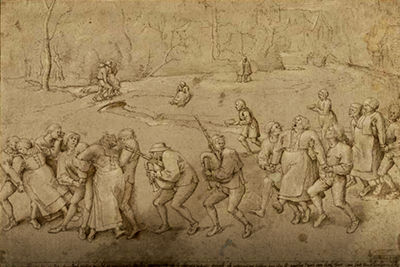There are several different versions of this drawing, with copies having been made at a later date. The original is believed to be the one found at the Albertina in Vienna, Austria.
Most of the interest in this drawing is in the foreground with a queue of individuals involved in a variety of slightly bizarre activities. Several figures appear to be being helped, maybe even held down by assistants as their unruly behaviour is tempered. Behind them is a number of further figures in the background as well as a scene that is relatively feint in tone, perhaps even unfinished. Bruegel may well have been practising on paper here for a later painting, which was a better use of time than attempting to amend oil works at a later date. Figurative portraits are known to be amongst the most challenging genres and so practice such as this was essential, even for those as naturally gifted as Pieter Bruegel the Elder.
This artwork was completed in pen on a small leaf of paper. Items such as these would often be handed around studios in order to direct assistants to work in a similar way to the master himself. This led to many original drawings being lost, damaged or even losing attribution over time, and so the drawings that have survived to the present day hold a particularly high value for artists such as Bruegel who appeared so many centuries ago.
There is a single line of writing at the bottom of the artwork which reads, in Dutch, "...dit sin dye pelgerommen di op sint Jans dach buyten bruessel te muelebeec danssen moeten ende als sy ouer een brugge gedanst oft gesprongen hebben dan sin sy genesen vor een heel Jaer van Sint Jans sieckte bruegel m.ccccc.Lxiiij..." The appearance of writing suggests again that this was intended as a means to expanding upon certain ideas, and it is likely that the artist was putting additional notes and observations alongside the work itself in order to plan the larger, upcoming painting. He did not do the same, for instance, in his landscape drawings which were often used for the production of etchings and woodcuts, and then prints from those. The final output enabled him to supplement his income and continue to work fairly independently.




